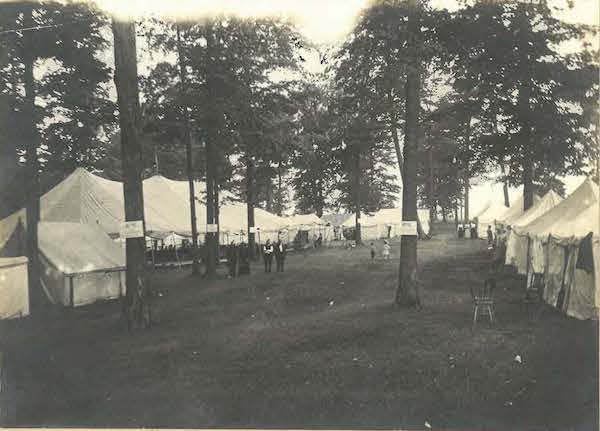This year, as we celebrate Emmanuel’s eightieth anniversary, we will be posting monthly articles on the history of the College.
January 16, 2020
In 1964 Emmanuel Bible College moved from its location on Ahrens Street in Kitchener to a large property on Fergus Avenue in the eastern part of the city. Throughout the nearly six decades since that move, the property has been a hub of activity for students, professors, and many others who are committed to serving Christ. However, the relocation of Emmanuel did not mark the beginning of Christian activity on the Fergus property. In fact, the land had been resounding with the sounds of praise and worship long before Emmanuel held its first classes.
Earlier in the century the property had been purchased by the Mennonite Brethren in Christ Church (MBC) and later had been owned by its successor denomination, the United Missionary Church, to which Emmanuel belonged. Both church organizations had used the property for Christian “camp meetings,” an important aspect of evangelicalism at the time. These beloved events, often held for over a week in the summer, in some ways resemble modern-day evangelical conferences. Participants would travel, often for long distances, to congregate for praise, prayer, and preaching. Sometimes professional evangelists would come to give impassioned sermons and encourage listeners to turn from sin and walk with Christ. Many had profound spiritual experiences and either committed to being a disciple for the first time or renewed their resolve to be servants of the Lord.
Though similar in these ways to modern conferences, camp meetings were much more rugged. Before cars became common, participants often travelled by train or horse and carriage. They camped out on the grounds, sleeping in tents and cooking their own food. Preachers, without microphones or impressive stages, raised their voices from simple platforms. Musicians, too, played without amplification.
A report from 1929 gives a glimpse into the kinds of experiences people had at the Fergus Avenue camp meetings. In the August 1 issue of The Gospel Banner, the MBC newspaper, Samuel Goudie gave a glowing description of the event and its successes. The preacher F. E. Arthur of Chicago was the evangelist, and the C.M.A. Gospel Quintette of Cleveland led the music. During one service the grounds were officially dedicated to God and were given the name Beulah Grove. Attendance was impressive: at various points throughout the eleven-day meeting, over 1,800 people were gathered on the property.
Most exciting, however, were the spiritual results. Goudie wrote, using the evangelical language of the day, “The special blessing of God was on every service, and many seekers bowed at the altar and pressed through to victory. I do not know the exact number, but some thought there were over two hundred. I know that in one service there were over thirty seekers.”
Much, of course, has changed on the Fergus property since 1929. However, more than ninety years later, people who come here are still committing their lives to Christ. For this we thank God and all those who have learned with us, served with us, and supported us over the years.
This article draws on the Missionary Church’s booklet 100 Years of Camp Meetings: 1881–1981. We also offer thanks to Clare Fuller and the Missionary Church Historical Trust for assistance with the research. The featured photograph shows a camp meeting on the Fergus Avenue property (courtesy of the Emmanuel Bible College Archives). The date is unknown.

